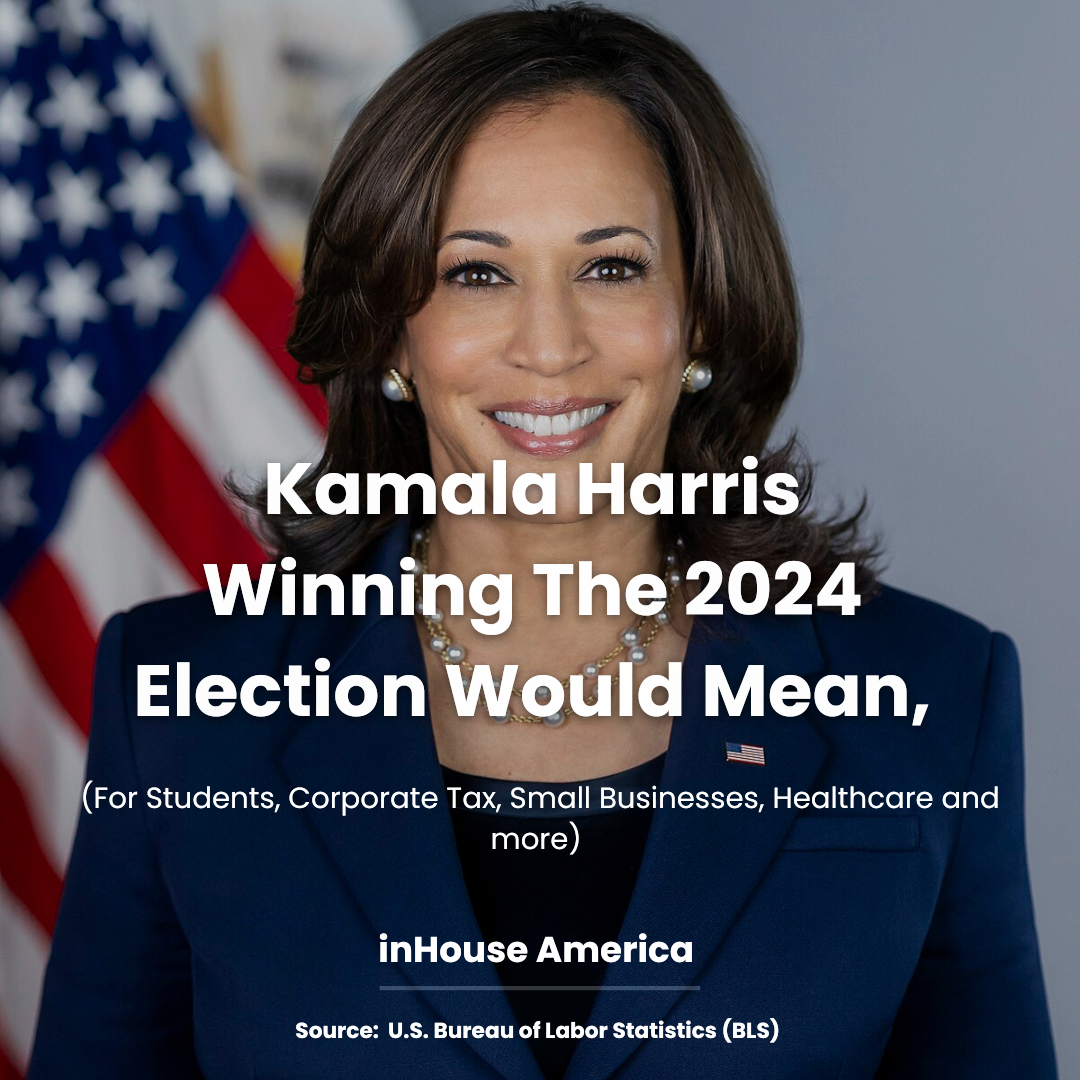InHouse America
How Kamala Harris' Policies Are Poised To Significantly Impact The U.S. Economy
Published: 14:40 pm (GMT-5), Tue September 3, 2024
3 Minute Read

Source: (U.S. Bureau of Labor Statistics (BLS) )
Job Creation and Employment
(American Jobs Plan)
Expected to create 19 million jobs over the next decade.
Source: (U.S. Department of Transportation)
Insights: This will affect 5.7% of the U.S. population, with a focus on infrastructure, clean energy, and manufacturing sectors.
(Employment Growth)
The economy has added 13.5 million jobs since January 2021.
Source: (U.S. Bureau of Labor Statistics, BLS)
Insights: This growth has reduced the unemployment rate from 6.3% to 3.5%, benefiting 10.8 million people who were previously unemployed.
Income Inequality Reduction
(Child Tax Credit Expansion)
Lifted 3.5 million children out of poverty, reducing the child poverty rate by 30%.
Source: (U.S. Census Bureau)
Insights: This impacted 8.4% of U.S. children, improving financial security for millions of families.
(Median Household Income)
Increased by 4.1% from 2020 to 2023, reaching $74,000.
Source: (U.S. Census Bureau)
Insights: This rise positively affected 128 million households across the nation.
Support for Small Businesses
(Paycheck Protection Program (PPP))
Provided over $800 billion in forgivable loans.
Source: (Small Business Administration, SBA)
Insights: Helped save an estimated 6.7 million jobs in small businesses, which account for 99.9% of all U.S. businesses.
(Small Business Growth)
Number of small businesses increased by 5.6% from 2021 to 2023.
Source: (Small Business Administration, SBA)
Insights: Minority-owned businesses grew by 8.3%, adding 2.2 million new businesses.
Healthcare
(Affordable Care Act (ACA) Expansion)
Expanded healthcare coverage to an additional 4 million people through increased subsidies and Medicaid expansion .
Source: (Centers for Medicare & Medicaid Services, CMS)
Insights: Uninsured rate dropped from 9.2% to 8.1%, benefiting approximately 3.6 million Americans (CMS).
(Prescription Drug Costs)
The administration’s efforts to lower prescription drug costs are expected to save Americans $150 billion over the next decade.
Source: (Congressional Budget Office, CBO)
Insights: This policy particularly impacts 46 million seniors enrolled in Medicare.
Student Loans
(Student Loan Forgiveness)
Proposed plan to cancel up to $20,000 per borrower for Pell Grant recipients and $10,000 for other borrowers.
Source: (U.S. Department of Education)
Insights: This would affect approximately 43 million borrowers, reducing student loan debt by $400 billion overall.
(Income-Driven Repayment (IDR) Plan)
New IDR plans cap monthly payments at 5% of discretionary income, down from 10%, benefiting 20 million borrowers.
Source: (U.S. Department of Education)
Insights: This would reduce the burden on borrowers earning less than $30,000 per year.
Inflation
(Inflation Reduction Act)
The Act aims to reduce the federal deficit by $300 billion over the next decade, potentially easing inflationary pressures.
Source: (Bureau of Labor Statistics, BLS)
Insights: Inflation has moderated from a peak of 9.1% in mid-2022 to 3.2% by mid-2024, helping to stabilize the cost of living for 330 million Americans.
(Energy and Food Prices)
Energy prices have decreased by 18% from their peak in 2022, and food price inflation has slowed to 4.5%, providing relief to all U.S. households
Source: (Bureau of Labor Statistics, BLS)
Insights:
Climate and Clean Energy Investments
(Clean Energy Jobs)
Investment expected to create 1.5 million jobs by 2030.
Source: (U.S. Department of Energy)
Insights: This will impact 0.45% of the U.S. population, mainly in states leading in renewable energy.
(Electric Vehicle (EV) Investment)
$174 billion committed to support EV transition, targeting 50% of all new car sales to be electric by 2030.
Source: (U.S. Department of Transportation)
Insights: This investment is projected to benefit over 330 million Americans by reducing carbon emissions and improving air quality.
Taxation and Fiscal Policy
(Corporate Tax Rate)
Proposed increase from 21% to 28% could generate an additional $2 trillion over a decade.
Source: (Congressional Budget Office, CBO)
Insights: Revenue would support infrastructure, healthcare, and education, indirectly benefiting 330 million Americans.
(Top Marginal Tax Rate Increase)
The increase from 37% to 39.6% for high earners would affect about 1.4 million people, generating more revenue for social programs.
Source: (Congressional Budget Office, CBO)
Policy Effects on InHouse America
Kamala Harris' economic policies, including 19 million new jobs, a drop in unemployment to 3.5%, and a $800 billion PPP loan expansion, are set to boost consumer spending and small business growth.
Source: (Congressional Budget Office, CBO)
Insights: With an increase in median household income and small business numbers, platforms like Inhouse America stand to benefit from a thriving small business ecosystem.
InHouse America doesn't endorse anyone but focuses on creating awareness of the importance of supporting small businesses and which administration is best for doing so!